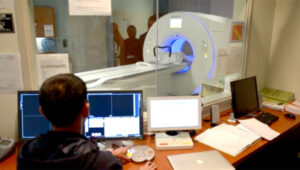
U.S. Naval Medical Center San Diego’s medical providers conduct a lung cancer screening. With November being Lung Cancer Awareness Month, be aware of symptoms, causes and steps to take if you think you need screening. (U.S. Navy Seaman Apprentice Harley Sarmiento, Naval Medical Center San Diego)
PORTLAND, OR — The National Lung Screening Trial (NLST), which began at the beginning of the 21st century, compared two ways of detecting lung cancer: low-dose helical computed tomography (CT)—often referred to as spiral CT—and standard chest X-ray.
Results suggested that participants who received low-dose helical CT scans had a 15% to 20% lower risk of dying from lung cancer than participants who received standard chest X-rays.
Now, novel targeted therapies and immunotherapies for advanced lung cancer have become available. A study in the journal Cancer looked at the effect of these treatment advances on the expected benefits of LDCT screening.1
The study was led by the Oregon Health & Science University and the VA Portland, OR, Health Care System. Researchers used a micro-simulation model of LDCT screening for high-risk individuals under standard systemic treatments–chemotherapy and radiation therapy—and novel treatments—immunotherapy and targeted therapy.
A reduction in advanced-stage disease consistent with the NLST was assumed by the model, and, based on diagnosis stage, survival was projected. The researchers noted that the disease-specific relative mortality reduction (MR) due to LDCT screening was projected in the trial setting and in a population eligible for LDCT screening under the current U.S. Preventive Services Task Force (USPSTF) recommendations.
The results indicate that the availability of novel treatments reduced the MR in the LDCT arm of the NLST from 15% to 13.5% and the number of lung cancer deaths prevented from 310 to 224 per 100,000 persons screened.
“Over 10 years, population LDCT screening based on USPSTF recommendations prevented 374 lung cancer deaths per 100,000 under standard treatments (13.3% MR) and 236 per 100,000 under fully adopted novel treatments (10.6% MR),” the authors pointed out. “The number needed to screen to avert one death over 10 years was 270 under standard treatments and 440 under novel treatments.”
The study predicted that the transition from standard systemic treatments to novel treatments will reduce the relative and absolute mortality benefits of LDCT screening, adding, “Benefit-harm tradeoffs of LDCT screening are likely to change as novel treatments become widespread.”
- Gogebakan KC, Lange J, Slatore CG, Etzioni R. Modeling the impact of novel systemic treatments on lung cancer screening benefits. Cancer. 2023 Jan 15;129(2):226-234. doi: 10.1002/cncr.34527. Epub 2022 Nov 1. PMID: 36320180.

